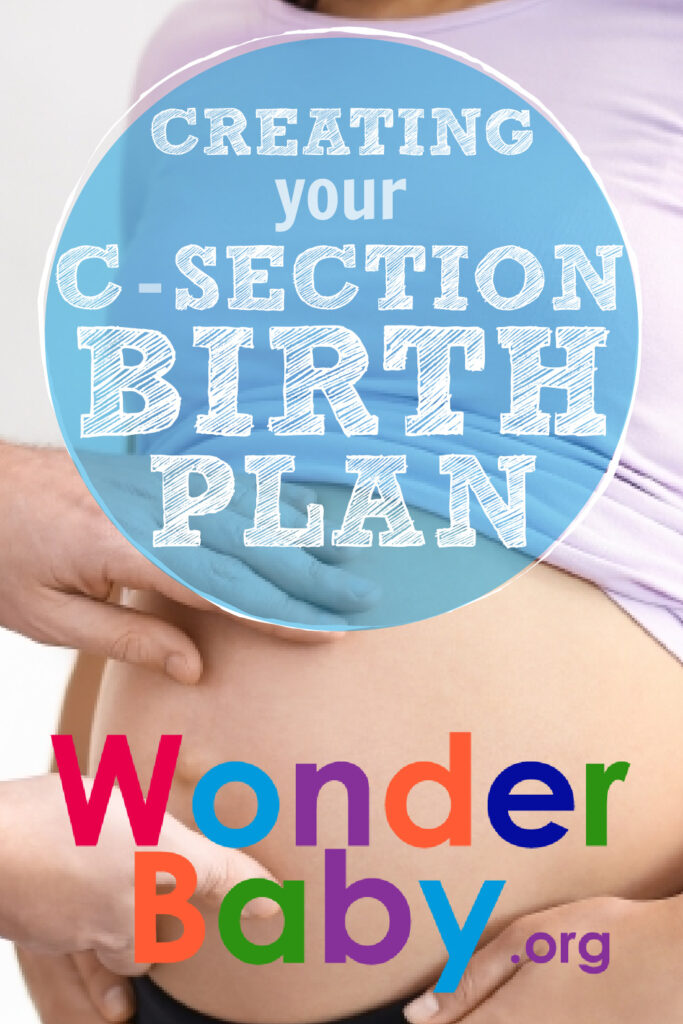Creating Your C-Section Birth Plan

- Having a C-section birth plan can help to ease anxiety on your big day.
- Even if you plan on a vaginal delivery, a back up C-section birth plan is good to have in case of emergency.
- A C-section birth plan should include things like who you want in the room, medication preferences, and how you’d like to recover.
About one-third of babies in the United States are born via C-section delivery. Cesarean birth is for mothers with placenta previa, previous C-section, or fetal distress. A cesarean section should be performed as soon as possible if your physician says you need it to save your baby’s life.
Even if you have plans for a vaginal birth, you should have a back up plan in mind in case of an emergency cesarean section. This can help you feel more calm and in control in the event of a surprise cesarean.
Whether it is expected or as a backup plan, work with your partner and physician on creating your C-section birth plan ahead of time.
What’s a C-section Birth Plan?
A cesarean birth plan is a nice guideline that your medical staff can look at to understand what is most important to you on the day of your baby’s birth.
Creating a C-section Birth Plan
When you create your C-section birth plan, talk to your medical provider, your partner, and your childbirth educator about possible scenarios and what is the most important to you. You can discuss different pain medications, preference for general anesthesia, breast or bottle feeding, and what family member you would like to have present with you in the operating theater.
Before you make your plan, you need to know what questions to ask. If you have never given birth before, or have never had a cesarean birth, you may want to ask a friend or family member about their experience. Ask them what they liked about their birth experience and what they wished would’ve gone differently. This can give you a good idea of what to add to your own birth plan.
Skin to skin time
Many women want to have the first moments of their baby’s life to have immediate skin to skin contact with both themselves and their support person. Others may want the doctor to assess the baby’s health immediately after their cesarean section. Discuss with your doctor the pros and cons of each.
Medications
Medications are a hot topic for many mothers. Some want as little medication as possible, while others feel comfortable receiving any medications that are recommended by the doctor. Choose whatever medication plan feels best for you.
Support people
You also want to have a plan for who you would like to have in the room with you for the birth of your baby. Ask your healthcare team if both a support person and doula will be allowed in the operating room with you. It is also important to find out about hospital visitor policies and set limits on who you want in the recovery room with you, especially during the first few hours.
Breastfeeding
Make sure to let your healthcare providers know if you plan on breastfeeding. That way, they can help you avoid the use of artificial nipples and get your baby to your breast as soon as possible after delivery.
Gentle cesarean
A gentle C-section, also called a family centered cesarean birth, is a plan that many moms choose as a backup plan for a natural birth. This plan includes being able to spend as much time with your baby as possible both in the operating room and using as few medications and medical interventions as you can.
Remember that your doctor and other hospital staff want what is best for you and your baby. They may have to make decisions contrary to your birth plan for medical reasons like high blood pressure or low blood sugars. Expecting parents should feel confident that the healthcare team will make the best decisions for mother and baby, while sticking as closely to your plan as possible.
A cesarean birth is a major surgery, and complications may come up. Choose a hospital that you trust to provide health and care excellence in case of emergencies.

Example C-Section Birth Plan
Now that you know what topics a C-section birth plan might cover, it might be helpful to actually see what a birth plan looks like. Here is a sample birth plan:
I understand that circumstances may arise that this plan may need to be adjusted. I would like to follow these guidelines as closely as possible, thank you.
- No preoperative sedative medications
- Epidural anesthesia only
- Partner in the room at all times
- Partner able to cut the umbilical cord
- Video and pictures allowed
- Breastfeeding as soon as possible
- Skin to skin contact immediately after birth
- No pacifiers or bottles
- Allow family to give first baby bath
- All pediatric exams with mother present
Sharing Your C-section Birth Plan
A birth plan is something very personal, and some people feel very strongly about their birth experience plan. Having a baby is a huge moment, and it is important to discuss expectations with your support person, birth educator, and physician before the big day.
Who to share your plan with
Definitely share your birth plan with your OBGYN, partner or support person, and birth coach if you have one. You may even want to share it with your pediatrician and a backup support person, just in case.
Discuss your plan with your coaches, support people, and medical providers before you commit to a birth plan. Your scheduled prenatal appointment around 30 weeks is a great time to start this discussion.
Making copies of your birth plan
Even an elective cesarean birth doesn’t always happen on the scheduled day. Babies seem to come into the world whenever they want, and towards the end of your pregnancy, it is smart to keep a copy of your birth plan nearby at all times.
You can keep copies in your hospital bag, the glove compartment of your car, and your wallet. You might consider keeping a digital copy on your phone, something you’re almost guaranteed to have with you when you go into labor.

Is a C-section Birth Plan Necessary?
With all of the planning that has to be done before a baby is born, making a C-section plan might feel like just something unnecessary to add to your list.
This is especially true for mothers determined to have a natural birth. It can be hard to think about needing an emergency C-section, and making a plan for one might feel stressful.
However, unless it is a scheduled C-section, or you have had one before, expecting parents can be caught off guard by an emergency C-section. Not knowing what to expect or having to make last-minute decisions can make an already stressful situation worse.
Sitting calmly before you go into labor to discuss the possibility of a C-section plan will help you remain calm if it does happen. It will also ensure that your healthcare team knows what is important to you and can do their best to meet your needs. This can also be a good time to plan for your post labor recovery needs.
FAQs
How long does a C-section usually last?
A C-section usually takes about 30-60 minutes from start to finish. Although the procedure is relatively fast, you will have to stay in the hospital for about three days after your C-section delivery. Take this time to rest and get some sleep after your C-section.
How long will it take to completely heal after a C-section?
It usually takes about 6 weeks to be completely healed from a C-section delivery. During those 6 weeks it is important to avoid heavy lifting, twisting, or intense exercise in order to avoid pain around your C-section scar. You should have a follow up appointment with your physician after 6 weeks to be cleared to return to all of your normal activities.
What if my doctor disagrees with my birth plan?
A physician should always respect your wishes, but hear them out if they have concerns about your birth plan. When you first find out you are pregnant, try to choose a provider whose healthcare philosophy aligns with yours. If your doctor has major safety concerns, you can get a second opinion from another licensed provider.

The information WonderBaby provides is not intended to be, and does not constitute, medical or other health advice or diagnosis and should not be used as such. Always consult with a qualified medical professional about your specific circumstances.
Related Posts

Pregnancy
How To Deal With an Ingrown Hair on a C-Section Scar
Ingrown hairs on a C-section scar can be treated using a warm compress or mild exfoliation. Infected ingrown hairs may require antibiotic treatment.

Pregnancy
What’s a Dye Stealer Pregnancy Test?
A dye stealer pregnancy test usually means that your hCG levels are very high, which is typically considered a good sign for pregnancy.

Pregnancy
Can Yelling Cause a Miscarriage?
Yelling alone can not cause a miscarriage. However, maternal stress can cause high blood pressure, preterm labor, and other health problems.